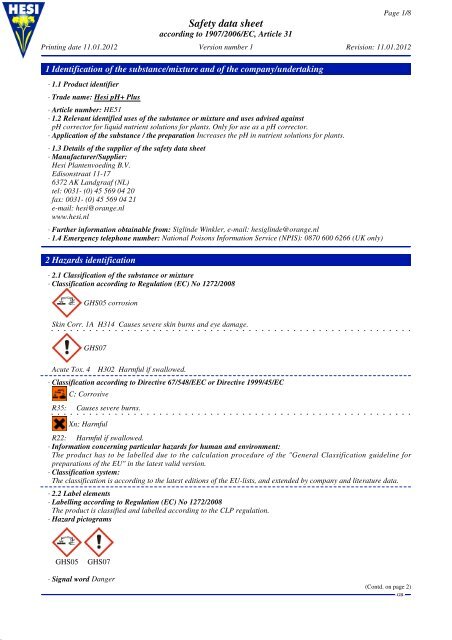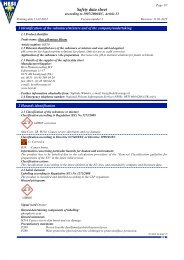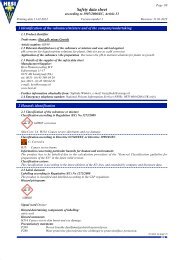MSDS Hesi pH+ Plus
MSDS Hesi pH+ Plus
MSDS Hesi pH+ Plus
You also want an ePaper? Increase the reach of your titles
YUMPU automatically turns print PDFs into web optimized ePapers that Google loves.
34.0.2<br />
Safety data sheet<br />
according to 1907/2006/EC, Article 31<br />
Page 1/8<br />
Printing date 11.01.2012 Version number 1<br />
Revision: 11.01.2012<br />
1 Identification of the substance/mixture and of the company/undertaking<br />
· 1.1 Product identifier<br />
· Trade name: <strong>Hesi</strong> <strong>pH+</strong> <strong>Plus</strong><br />
· Article number: HE51<br />
· 1.2 Relevant identified uses of the substance or mixture and uses advised against<br />
pH corrector for liquid nutrient solutions for plants. Only for use as a pH corrector.<br />
· Application of the substance / the preparation Increases the pH in nutrient solutions for plants.<br />
· 1.3 Details of the supplier of the safety data sheet<br />
· Manufacturer/Supplier:<br />
<strong>Hesi</strong> Plantenvoeding B.V.<br />
Edisonstraat 11-17<br />
6372 AK Landgraaf (NL)<br />
tel: 0031- (0) 45 569 04 20<br />
fax: 0031- (0) 45 569 04 21<br />
e-mail: hesi@orange.nl<br />
www.hesi.nl<br />
· Further information obtainable from: Siglinde Winkler, e-mail: hesiglinde@orange.nl<br />
· 1.4 Emergency telephone number: National Poisons Information Service (NPIS): 0870 600 6266 (UK only)<br />
2 Hazards identification<br />
· 2.1 Classification of the substance or mixture<br />
· Classification according to Regulation (EC) No 1272/2008<br />
GHS05 corrosion<br />
Skin Corr. 1A H314 Causes severe skin burns and eye damage.<br />
GHS07<br />
Acute Tox. 4<br />
H302 Harmful if swallowed.<br />
· Classification according to Directive 67/548/EEC or Directive 1999/45/EC<br />
C; Corrosive<br />
R35: Causes severe burns.<br />
Xn; Harmful<br />
R22: Harmful if swallowed.<br />
· Information concerning particular hazards for human and environment:<br />
The product has to be labelled due to the calculation procedure of the "General Classification guideline for<br />
preparations of the EU" in the latest valid version.<br />
· Classification system:<br />
The classification is according to the latest editions of the EU-lists, and extended by company and literature data.<br />
· 2.2 Label elements<br />
· Labelling according to Regulation (EC) No 1272/2008<br />
The product is classified and labelled according to the CLP regulation.<br />
· Hazard pictograms<br />
GHS05<br />
GHS07<br />
· Signal word Danger<br />
(Contd. on page 2)<br />
GB
34.0.2<br />
Safety data sheet<br />
according to 1907/2006/EC, Article 31<br />
Page 2/8<br />
Printing date 11.01.2012 Version number 1<br />
Revision: 11.01.2012<br />
Trade name: <strong>Hesi</strong> <strong>pH+</strong> <strong>Plus</strong><br />
(Contd. of page 1)<br />
· Hazard-determining components of labelling:<br />
potassium hydroxide<br />
· Hazard statements<br />
H302 Harmful if swallowed.<br />
H314 Causes severe skin burns and eye damage.<br />
· Precautionary statements<br />
P260<br />
Do not breathe dust/fume/gas/mist/vapours/spray.<br />
P280<br />
Wear protective gloves/protective clothing/eye protection/face protection.<br />
P303+P361+P353 IF ON SKIN (or hair): Remove/Take off immediately all contaminated clothing. Rinse skin with<br />
water/shower.<br />
P305+P351+P338 IF IN EYES: Rinse cautiously with water for several minutes. Remove contact lenses, if present<br />
and easy to do. Continue rinsing.<br />
P310<br />
Immediately call a POISON CENTER or doctor/physician.<br />
P304+P340 IF INHALED: Remove victim to fresh air and keep at rest in a position comfortable for<br />
breathing.<br />
P301+P312 IF SWALLOWED: Call a POISON CENTER or doctor/physician if you feel unwell.<br />
P321<br />
Specific treatment (see on this label).<br />
P405<br />
P501<br />
Store locked up.<br />
Dispose of contents/container in accordance with local/regional/national/international<br />
regulations.<br />
· 2.3 Other hazards<br />
· Results of PBT and vPvB assessment<br />
· PBT:<br />
Does not meet the specific criteria detailed in Annex XII of Regulation 1907/2006 and the substances is not<br />
considered as a PBT.<br />
· vPvB:<br />
Does not meet the specific criteria detailed in Annex XII of Regulation 1907/2006 and the substances is not<br />
considered as a vPvB.<br />
* 3 Composition/information on ingredients<br />
· 3.2 Mixtures<br />
· Description: Mixture of substances listed below with nonhazardous additions.<br />
· Dangerous components:<br />
CAS: 1310-58-3<br />
EINECS: 215-181-3<br />
potassium hydroxide<br />
C R35; Xn R22<br />
Skin Corr. 1A, H314; Acute Tox. 4, H302<br />
· Additional information: For the wording of the listed risk phrases refer to section 16.<br />
40 - 60%<br />
4 First aid measures<br />
· 4.1 Description of first aid measures<br />
· General information:<br />
Immediately remove any clothing soiled by the product.<br />
Symptoms of poisoning may even occur after several hours; therefore medical observation for at least 48 hours after<br />
the accident.<br />
· After inhalation:<br />
In case of unconsciousness place patient stably in side position for transportation.<br />
Take affected persons into fresh air and keep quiet.<br />
Seek medical treatment.<br />
· After skin contact:<br />
Remove contaminated clothing and shoes.<br />
Immediately wash with water and soap and rinse thoroughly.<br />
Seek medical treatment.<br />
· After eye contact:<br />
Rinse opened eye for several minutes under running water. Then consult a doctor.<br />
Seek immediate medical advice.<br />
(Contd. on page 3)<br />
GB
34.0.2<br />
Safety data sheet<br />
according to 1907/2006/EC, Article 31<br />
Page 3/8<br />
Printing date 11.01.2012 Version number 1<br />
Revision: 11.01.2012<br />
Trade name: <strong>Hesi</strong> <strong>pH+</strong> <strong>Plus</strong><br />
(Contd. of page 2)<br />
· After swallowing:<br />
Call for a doctor immediately.<br />
Drink plenty of water and provide fresh air. Call for a doctor immediately.<br />
· 4.2 Most important symptoms and effects, both acute and delayed<br />
The material is extremely destructive to mucous membranes and upper respiratory tract, eyes and skin.<br />
· 4.3 Indication of any immediate medical attention and special treatment needed<br />
No further relevant information available.<br />
5 Firefighting measures<br />
· 5.1 Extinguishing media<br />
· Suitable extinguishing agents:<br />
CO2, powder or water spray. Fight larger fires with water spray or alcohol resistant foam.<br />
· For safety reasons unsuitable extinguishing agents: Water with full jet<br />
· 5.2 Special hazards arising from the substance or mixture<br />
Formation of toxic gases is possible during heating or in case of fire.<br />
· 5.3 Advice for firefighters<br />
· Protective equipment: Standard protective clothing for firefighters.<br />
6 Accidental release measures<br />
· 6.1 Personal precautions, protective equipment and emergency procedures<br />
Wear protective equipment. Keep unprotected persons away.<br />
Do not breathe fumes.<br />
· 6.2 Environmental precautions: Do not allow to enter sewers/ surface or ground water.<br />
· 6.3 Methods and material for containment and cleaning up:<br />
Absorb with liquid-binding material (sand, diatomite, acid binders, universal binders, sawdust).<br />
Dispose contaminated material as waste according to item 13.<br />
Ensure adequate ventilation.<br />
· 6.4 Reference to other sections<br />
See Section 7 for information on safe handling.<br />
See Section 8 for information on personal protection equipment.<br />
See Section 13 for disposal information.<br />
7 Handling and storage<br />
· 7.1 Precautions for safe handling<br />
Ensure good ventilation/exhaustion at the workplace.<br />
Prevent formation of aerosols.<br />
· Information about fire - and explosion protection: No special measures required.<br />
· 7.2 Conditions for safe storage, including any incompatibilities<br />
· Storage:<br />
· Requirements to be met by storerooms and receptacles:<br />
Store in a cool, dry, well ventilated place.<br />
Store only in the original receptacle.<br />
Comply to national regulations.<br />
· Information about storage in one common storage facility: Do not store together with acids.<br />
· Further information about storage conditions: Keep container tightly sealed.<br />
· 7.3 Specific end use(s) No further relevant information available.<br />
8 Exposure controls/personal protection<br />
· Additional information about design of technical facilities: No further data; see item 7.<br />
(Contd. on page 4)<br />
GB
34.0.2<br />
Safety data sheet<br />
according to 1907/2006/EC, Article 31<br />
Page 4/8<br />
Printing date 11.01.2012 Version number 1<br />
Revision: 11.01.2012<br />
Trade name: <strong>Hesi</strong> <strong>pH+</strong> <strong>Plus</strong><br />
· 8.1 Control parameters<br />
· Ingredients with limit values that require monitoring at the workplace:<br />
1310-58-3 potassium hydroxide<br />
WEL Short-term value: 2 mg/m³<br />
· Additional information: The lists valid during the making were used as basis.<br />
· 8.2 Exposure controls<br />
· Personal protective equipment:<br />
· General protective and hygienic measures:<br />
Ensure good ventilation/exhaustion at the workplace.<br />
Immediately remove all soiled and contaminated clothing<br />
Keep away from foodstuffs, beverages and feed.<br />
The usual precautionary measures are to be adhered to when handling chemicals.<br />
Avoid contact with the skin.<br />
Wash hands before breaks and at the end of work.<br />
Avoid contact with the eyes and skin.<br />
· Respiratory protection:<br />
Use of respiratory protection is recommended if the workplace limit is exceeded.<br />
Self-contained respiratory protective device.<br />
· Protection of hands:<br />
(Contd. of page 3)<br />
Protective gloves<br />
The glove material has to be impermeable and resistant to the product/ the substance/ the preparation.<br />
Due to missing tests no recommendation to the glove material can be given for the product/ the preparation/ the<br />
chemical mixture.<br />
Selection of the glove material on consideration of the penetration times, rates of diffusion and the degradation<br />
· Material of gloves<br />
The selection of the suitable gloves does not only depend on the material, but also on further marks of quality and<br />
varies from manufacturer to manufacturer. As the product is a preparation of several substances, the resistance of<br />
the glove material can not be calculated in advance and has therefore to be checked prior to the application.<br />
Nitrile rubber, NBR<br />
Recommended thickness of the material: ≥ 0.1 mm<br />
· Penetration time of glove material<br />
The exact break through time has to be found out by the manufacturer of the protective gloves and has to be<br />
observed.<br />
Value for the permeation: Level ≥ 6<br />
· Eye protection:<br />
Tightly sealed goggles<br />
· Body protection: Alkaline resistant protective clothing<br />
9 Physical and chemical properties<br />
· 9.1 Information on basic physical and chemical properties<br />
· General Information<br />
· Appearance:<br />
Form:<br />
Liquid<br />
Colour:<br />
Colourless<br />
· Odour: Odourless<br />
· Odour threshold: Not determined.<br />
(Contd. on page 5)<br />
GB
34.0.2<br />
Safety data sheet<br />
according to 1907/2006/EC, Article 31<br />
Page 5/8<br />
Printing date 11.01.2012 Version number 1<br />
Revision: 11.01.2012<br />
Trade name: <strong>Hesi</strong> <strong>pH+</strong> <strong>Plus</strong><br />
· pH-value at 20°C: 13<br />
· Change in condition<br />
Melting point/Melting range: - 20°C<br />
Boiling point/Boiling range: > 150°C<br />
· Flash point: Not applicable.<br />
· Flammability (solid, gaseous): Not applicable.<br />
· Ignition temperature:<br />
Decomposition temperature:<br />
Not determined.<br />
· Self-igniting: Product is not self-igniting.<br />
· Danger of explosion: Product does not present an explosion hazard.<br />
· Explosion limits:<br />
Lower:<br />
Upper:<br />
Not determined.<br />
Not determined.<br />
· Vapour pressure: Not determined.<br />
· Density at 20°C: 1.45 g/cm³<br />
· Relative density Not determined.<br />
· Vapour density Not determined.<br />
· Evaporation rate Not determined.<br />
· Solubility in / Miscibility with<br />
water:<br />
Fully miscible.<br />
· Segregation coefficient (n-octanol/water): Not determined.<br />
· Viscosity:<br />
Dynamic:<br />
Kinematic:<br />
Not determined.<br />
Not determined.<br />
· Solvent content:<br />
Organic solvents: 0.0 %<br />
Water: 50.0 %<br />
· 9.2 Other information No further relevant information available.<br />
(Contd. of page 4)<br />
10 Stability and reactivity<br />
· 10.1 Reactivity<br />
· 10.2 Chemical stability<br />
· Thermal decomposition / conditions to be avoided: No decomposition if used according to specifications.<br />
· 10.3 Possibility of hazardous reactions<br />
Strong exothermic reaction with acids.<br />
Reacts with light alloys to form hydrogen.<br />
· 10.4 Conditions to avoid No further relevant information available.<br />
· 10.5 Incompatible materials: Contact with strong acids<br />
· 10.6 Hazardous decomposition products: No dangerous decomposition products known.<br />
11 Toxicological information<br />
· 11.1 Information on toxicological effects<br />
· Acute toxicity:<br />
· LD/LC50 values relevant for classification:<br />
1310-58-3 potassium hydroxide<br />
Oral LD50 273 mg/kg (rat)<br />
(Contd. on page 6)<br />
GB
34.0.2<br />
Safety data sheet<br />
according to 1907/2006/EC, Article 31<br />
Page 6/8<br />
Printing date 11.01.2012 Version number 1<br />
Revision: 11.01.2012<br />
Trade name: <strong>Hesi</strong> <strong>pH+</strong> <strong>Plus</strong><br />
(Contd. of page 5)<br />
· Primary irritant effect:<br />
· on the skin: Strong caustic effect on skin and mucous membranes.<br />
· on the eye: Strong caustic effect.<br />
· Respiratory tract: Corrosive for the respiratory tract.<br />
· Sensitization: No sensitizing effects known.<br />
· Additional toxicological information:<br />
The product shows the following dangers according to the calculation method of the General EU Classification<br />
Guidelines for Preparations as issued in the latest version:<br />
Harmful<br />
Corrosive<br />
Swallowing will lead to a strong caustic effect on mouth and throat and to the danger of perforation of esophagus<br />
and stomach.<br />
12 Ecological information<br />
· 12.1 Toxicity<br />
· Aquatic toxicity: No further relevant information available.<br />
· 12.2 Persistence and degradability No further relevant information available.<br />
· 12.3 Bioaccumulative potential No further relevant information available.<br />
· 12.4 Mobility in soil No further relevant information available.<br />
· Additional ecological information:<br />
· General notes:<br />
Water hazard class 1 (German Regulation) (Self-assessment): slightly hazardous for water<br />
Do not allow undiluted product or large quantities of it to reach ground water, water course or sewage system.<br />
Must not reach sewage water or drainage ditch undiluted or unneutralized.<br />
Rinse off of bigger amounts into drains or the aquatic environment may lead to increased pH-values. A high pHvalue<br />
harms aquatic organisms. In the dilution of the use-level the pH-value is considerably reduced, so that after the<br />
use of the product the aqueous waste, emptied into drains, is only low water-dangerous.<br />
· 12.5 Results of PBT and vPvB assessment<br />
· PBT:<br />
Does not meet the specific criteria detailed in Annex XII of Regulation 1907/2006 and the substances is not<br />
considered as a PBT.<br />
· vPvB:<br />
Does not meet the specific criteria detailed in Annex XII of Regulation 1907/2006 and the substances is not<br />
considered as a vPvB.<br />
· 12.6 Other adverse effects No further relevant information available.<br />
13 Disposal considerations<br />
· 13.1 Waste treatment methods<br />
· Recommendation<br />
Must not be disposed together with household garbage. Do not allow product to reach sewage system.<br />
After prior treatment product has to be landfilled or incinerated adhering to the regulations pertaining to the<br />
disposal of especially hazardous waste.<br />
· Uncleaned packaging:<br />
· Recommendation: Disposal must be made according to official regulations.<br />
· Recommended cleansing agents: Water, if necessary together with cleansing agents.<br />
14 Transport information<br />
· 14.1 UN-Number<br />
· ADR, IMDG, IATA UN1814<br />
· 14.2 UN proper shipping name<br />
· ADR 1814 POTASSIUM HYDROXIDE SOLUTION<br />
· IMDG, IATA POTASSIUM HYDROXIDE SOLUTION<br />
(Contd. on page 7)<br />
GB
34.0.2<br />
Safety data sheet<br />
according to 1907/2006/EC, Article 31<br />
Page 7/8<br />
Printing date 11.01.2012 Version number 1<br />
Revision: 11.01.2012<br />
Trade name: <strong>Hesi</strong> <strong>pH+</strong> <strong>Plus</strong><br />
· 14.3 Transport hazard class(es)<br />
· ADR<br />
(Contd. of page 6)<br />
· Class 8 Corrosive substances.<br />
· Label 8<br />
· IMDG, IATA<br />
· Class 8 Corrosive substances.<br />
· Label 8<br />
· 14.4 Packing group<br />
· ADR, IMDG, IATA II<br />
· 14.5 Environmental hazards:<br />
· Marine pollutant: No<br />
· 14.6 Special precautions for user Warning: Corrosive substances.<br />
· Danger code (Kemler): 80<br />
· EMS Number: F-A,S-B<br />
· Segregation groups Alkalis<br />
· 14.7 Transport in bulk according to Annex II of<br />
MARPOL73/78 and the IBC Code<br />
· Transport/Additional information:<br />
· ADR<br />
· Tunnel restriction code E<br />
Not applicable.<br />
· UN "Model Regulation": UN1814, POTASSIUM HYDROXIDE SOLUTION, 8, II<br />
15 Regulatory information<br />
· 15.2 Chemical safety assessment: A Chemical Safety Assessment has not been carried out.<br />
16 Other information<br />
This information is based on our present knowledge. However, this shall not constitute a guarantee for any specific<br />
product features and shall not establish a legally valid contractual relationship.<br />
· Relevant phrases<br />
H302 Harmful if swallowed.<br />
H314 Causes severe skin burns and eye damage.<br />
R22 Harmful if swallowed.<br />
R35 Causes severe burns.<br />
· Abbreviations and acronyms:<br />
ADR: Accord européen sur le transport des marchandises dangereuses par Route (European Agreement concerning the International Carriage<br />
of Dangerous Goods by Road)<br />
RID: Règlement international concernant le transport des marchandises dangereuses par chemin de fer (Regulations Concerning the<br />
International Transport of Dangerous Goods by Rail)<br />
IMDG: International Maritime Code for Dangerous Goods<br />
IATA: International Air Transport Association<br />
ICAO: International Civil Aviation Organization<br />
GHS: Globally Harmonized System of Classification and Labelling of Chemicals<br />
(Contd. on page 8)<br />
GB
34.0.2<br />
Safety data sheet<br />
according to 1907/2006/EC, Article 31<br />
Page 8/8<br />
Printing date 11.01.2012 Version number 1<br />
Revision: 11.01.2012<br />
Trade name: <strong>Hesi</strong> <strong>pH+</strong> <strong>Plus</strong><br />
LC50: Lethal concentration, 50 percent<br />
LD50: Lethal dose, 50 percent<br />
· * Data compared to the previous version altered.<br />
(Contd. of page 7)<br />
GB





